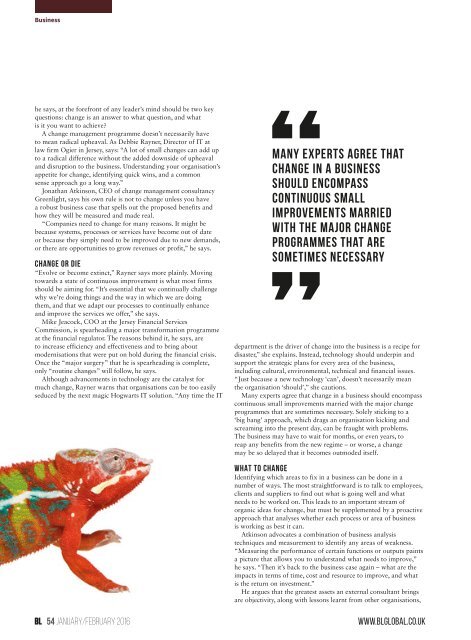BL Magazine
Create successful ePaper yourself
Turn your PDF publications into a flip-book with our unique Google optimized e-Paper software.
Business<br />
he says, at the forefront of any leader’s mind should be two key<br />
questions: change is an answer to what question, and what<br />
is it you want to achieve?<br />
A change management programme doesn’t necessarily have<br />
to mean radical upheaval. As Debbie Rayner, Director of IT at<br />
law firm Ogier in Jersey, says: “A lot of small changes can add up<br />
to a radical difference without the added downside of upheaval<br />
and disruption to the business. Understanding your organisation’s<br />
appetite for change, identifying quick wins, and a common<br />
sense approach go a long way.”<br />
Jonathan Atkinson, CEO of change management consultancy<br />
Greenlight, says his own rule is not to change unless you have<br />
a robust business case that spells out the proposed benefits and<br />
how they will be measured and made real.<br />
“Companies need to change for many reasons. It might be<br />
because systems, processes or services have become out of date<br />
or because they simply need to be improved due to new demands,<br />
or there are opportunities to grow revenues or profit,” he says.<br />
CHANGE OR DIE<br />
“Evolve or become extinct,” Rayner says more plainly. Moving<br />
towards a state of continuous improvement is what most firms<br />
should be aiming for. “It’s essential that we continually challenge<br />
why we’re doing things and the way in which we are doing<br />
them, and that we adapt our processes to continually enhance<br />
and improve the services we offer,” she says.<br />
Mike Jeacock, COO at the Jersey Financial Services<br />
Commission, is spearheading a major transformation programme<br />
at the financial regulator. The reasons behind it, he says, are<br />
to increase efficiency and effectiveness and to bring about<br />
modernisations that were put on hold during the financial crisis.<br />
Once the “major surgery” that he is spearheading is complete,<br />
only “routine changes” will follow, he says.<br />
Although advancements in technology are the catalyst for<br />
much change, Rayner warns that organisations can be too easily<br />
seduced by the next magic Hogwarts IT solution. “Any time the IT<br />
Many experts agree that<br />
change in a business<br />
should encompass<br />
continuous small<br />
improvements married<br />
with the major change<br />
programmes that are<br />
sometimes necessary<br />
department is the driver of change into the business is a recipe for<br />
disaster,” she explains. Instead, technology should underpin and<br />
support the strategic plans for every area of the business,<br />
including cultural, environmental, technical and financial issues.<br />
“Just because a new technology ‘can’, doesn’t necessarily mean<br />
the organisation ‘should’,” she cautions.<br />
Many experts agree that change in a business should encompass<br />
continuous small improvements married with the major change<br />
programmes that are sometimes necessary. Solely sticking to a<br />
‘big bang’ approach, which drags an organisation kicking and<br />
screaming into the present day, can be fraught with problems.<br />
The business may have to wait for months, or even years, to<br />
reap any benefits from the new regime – or worse, a change<br />
may be so delayed that it becomes outmoded itself.<br />
WHAT TO CHANGE<br />
Identifying which areas to fix in a business can be done in a<br />
number of ways. The most straightforward is to talk to employees,<br />
clients and suppliers to find out what is going well and what<br />
needs to be worked on. This leads to an important stream of<br />
organic ideas for change, but must be supplemented by a proactive<br />
approach that analyses whether each process or area of business<br />
is working as best it can.<br />
Atkinson advocates a combination of business analysis<br />
techniques and measurement to identify any areas of weakness.<br />
“Measuring the performance of certain functions or outputs paints<br />
a picture that allows you to understand what needs to improve,”<br />
he says. “Then it’s back to the business case again – what are the<br />
impacts in terms of time, cost and resource to improve, and what<br />
is the return on investment.”<br />
He argues that the greatest assets an external consultant brings<br />
are objectivity, along with lessons learnt from other organisations,<br />
54 January/february 2016 www.blglobal.co.uk

















